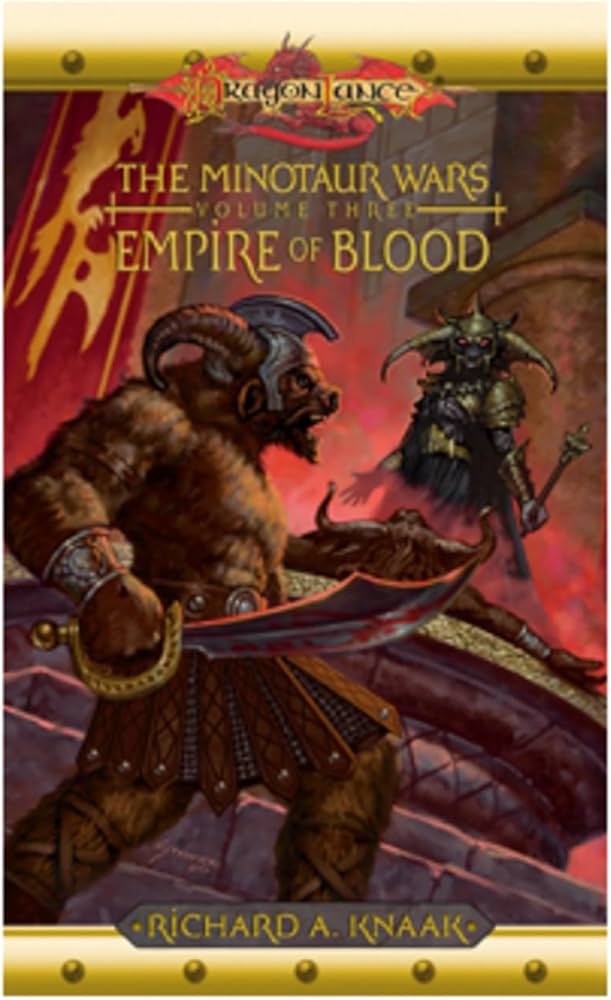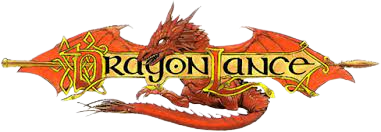Empire of Blood

Table of Contents
ToggleOverview
Empire of Blood is the dramatic conclusion to the Minotaur Wars Trilogy, a tale of militarism, tyranny, and divine reckoning in the Dragonlance universe. This novel escalates the stakes of the previous volumes, bringing the brutal rise of the minotaur empire under Emperor Hotak to a thunderous and tragic climax.
Blending political intrigue, divine manipulation, and battlefield spectacle, the novel explores how empires fall—not just from outside forces, but from the rot within. It is a story of sacrifice, rebellion, and the ultimate cost of glory.
Main Character: Hotak de-Droka
Once a general, now the ruthless self-declared Emperor of the minotaurs, Hotak rules through blood, fire, and fanatical loyalty.
Haunted by prophecy and tormented by his devotion to the dark god Sargas, Hotak is both conqueror and prisoner of his own ambition.
As his empire begins to crumble under rebellion and divine punishment, Hotak descends further into madness, believing only he can save his people—even from themselves.
Supporting Characters
Meksa – A priest of Sargas who begins to question his faith and Hotak’s interpretation of divine will. His arc reflects the spiritual fallout of tyranny.
Hul – A loyal but increasingly conflicted commander in Hotak’s army. Hul must choose between loyalty to the empire and doing what is right.
Kezrak – A minotaur revolutionary who represents the resistance. His insurgent movement forces Hotak to face the rage of those he has oppressed.
The Dark Knights – Human allies of the minotaurs who bring their own political agenda, complicating the empire’s power structure.
Setting
The novel is primarily set in the Imperial Palace of Nethosak, capital of the minotaur empire, but it also ranges across battlefields, fortresses, and sacred sites tied to the worship of Sargas.
The setting is heavy with symbolism: marble halls stained with blood, crumbling temples, and sea-swept coasts where the empire meets its doom.
As the empire collapses, so does the grandeur of its surroundings. The setting reinforces the idea that all empires are temporary—especially those built on tyranny.
Plot Summary
Cracks in the Empire
Hotak, now Emperor, rules the minotaurs with an iron fist. His religious fervor and violent conquests have expanded the empire, but at great cost.
Rebellions break out across the provinces, fueled by overtaxation, divine omens, and Hotak’s increasingly erratic rule. Allies become enemies. Prophecies speak of a fall.
Resistance Rises
Kezrak leads a daring rebellion, gaining support among disenfranchised soldiers and civilians. Meanwhile, Hul begins to question Hotak’s decrees, witnessing cruelty that defies even minotaur honor.
Meksa confronts visions from Sargas that suggest Hotak has twisted the god’s will. Torn between fear and faith, he begins to plot.
Blood and Fire
As the empire teeters, civil war erupts. Hul is forced into a choice: uphold his oath to the Emperor or fight for a better future.
Hotak’s madness reaches its peak. He orders purges and sacrifices, believing his divine destiny demands ever more blood.
The final battle sees Nethosak engulfed in fire. Kezrak confronts Hotak. Meksa completes a spiritual act of rebellion. Hul faces his former leader one last time.
Hotak dies not as a god-emperor, but as a man undone by pride, prophecy, and the ghosts of his own making.
Themes
Power and Corruption – The novel shows how absolute power leads to moral decay, even when clothed in religious righteousness.
Faith and Doubt – The clash between divine will and mortal interpretation underscores the dangers of blind zealotry.
Loyalty vs. Conscience – Characters like Hul are torn between obedience and righteousness, showcasing the costs of moral clarity.
The End of Empires – All glory fades. The story emphasizes that the mightiest nations can crumble when built on blood and fear.
Tone & Style
Empire of Blood is intense, brutal, and tragic. The prose reflects the grandeur and downfall of its setting, filled with dramatic speeches, harrowing battles, and internal anguish.
There is a mythic tone to Hotak’s arc—a rise-and-fall narrative that echoes classical tragedy, with blood-soaked visuals and divine interference.
The pacing is urgent, matching the sense of collapse, with moments of pause for philosophical and theological reflection.
Reception
Empire of Blood is praised for:
Delivering a powerful conclusion to the Minotaur Wars Trilogy.
A compelling, morally complex central figure in Hotak.
Strong themes of rebellion, redemption, and spiritual crisis.
Some critiques:
The violence and darkness may be overwhelming for some readers.
Hotak’s descent into madness can feel repetitive, though it adds to the tragic structure.
Final Thoughts
Empire of Blood is a fitting end to a brutal and philosophically rich trilogy. It doesn’t glorify power—it deconstructs it, showing how empires fall not just by sword and fire, but by the failing hearts of those who lead them.
This is a story about faith lost and reclaimed, about what loyalty means in the face of horror, and about how even the strongest must answer to history.
Recommended for:
Fans of darker, militaristic fantasy.
Readers interested in morally gray characters and the fall of tyrants.
Those drawn to themes of divine judgment, rebellion, and tragic downfall.
